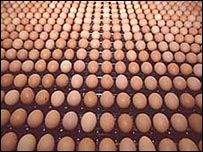Newly released reports pointing to years of positive salmonella tests at an Iowa egg facility have baffled some experts and egg producers.
Elizabeth Weise writes in today’s USA Today that Congressional investigators have obtained records that show Wright County Egg had evidence of even more problems than filth and vermin, as reported by the .jpg) Food and Drug Administration last month. The records show that over the past three years, Wright County, the company at the center of the outbreak that sickened about 1,519 people and led to the recall of 550 million eggs, had multiple positive tests for salmonella in its plant that it did not report.
Food and Drug Administration last month. The records show that over the past three years, Wright County, the company at the center of the outbreak that sickened about 1,519 people and led to the recall of 550 million eggs, had multiple positive tests for salmonella in its plant that it did not report.
Numbers that high over that time period indicate "the environmental contamination is widespread on these farms," says Darrell Trampel, professor of production animal medicine at Iowa State University in Ames. "Maybe six to 12 positives … wouldn’t be surprising, but 73 is relatively high."
Besides, "if he’s getting repeated positives back on consecutive tests, that tells you that you’re not getting to the root cause of what the problem is," says Patricia Curtis, director of the poultry products safety program at Auburn University in Alabama.
Dave Thompson, owner of Pearl Valley Eggs in Pearl City, Ill., who produces 800,000 to 850,000 eggs a day, seven days a week, and was featured in a Weise report last month, says he can’t imagine getting numbers like Wright County’s. "I’ve never had a positive, and I test all the time," he says.
Under FDA rules put into place in July, large egg production facilities that have positive tests for salmonella enteritidis will be required to test 1,000 eggs four times at two-week intervals. "If even one egg tests positive, it’s mandatory that those eggs … be pasteurized," Trampel says.
Big ag doesn’t mean bad ag. Organic or conventional, local or global, big or small, there are good farmers and bad farmers. The good ones know all (1).jpg) about food safety and continuously work to minimize levels of risk.
about food safety and continuously work to minimize levels of risk.
Consumers have no way of knowing which eggs or foods were produced by microbiologically prudent farmers and which were produced on dumps. Market microbial food safety at retail so consumers can choose.

 nearest town, is a neat collection of 350-foot- and 450-foot henhouses covered in white steel siding. They’re linked by overhead pipes that bring in ground corn and soybeans from the farm’s own feed mill and conveyor belts that take out chicken poop.
nearest town, is a neat collection of 350-foot- and 450-foot henhouses covered in white steel siding. They’re linked by overhead pipes that bring in ground corn and soybeans from the farm’s own feed mill and conveyor belts that take out chicken poop. "Small farms produce the safest food available, without regulation. … Just like family farms brought us out of the Great Depression, they can bring us out of the food safety problem and this recession, if they are allowed to thrive.”
"Small farms produce the safest food available, without regulation. … Just like family farms brought us out of the Great Depression, they can bring us out of the food safety problem and this recession, if they are allowed to thrive.”.jpg) But over time, my own knowledge increased, and I realized that several of these exposes were really just literary clichés, citing a few sources here and there, usually to validate a pre-existing ideal.
But over time, my own knowledge increased, and I realized that several of these exposes were really just literary clichés, citing a few sources here and there, usually to validate a pre-existing ideal..jpg) As the Times story put it,
As the Times story put it,.jpg) What can be said is that local/small/organic is a lifestyle choice. And like any lifestyle choice, go for it but play safe. Try not to make people barf and even embrace evidence-based microbiologically safe food. Sales will probably increase.
What can be said is that local/small/organic is a lifestyle choice. And like any lifestyle choice, go for it but play safe. Try not to make people barf and even embrace evidence-based microbiologically safe food. Sales will probably increase..jpg) The best and most dangerous mythology in the story is this:
The best and most dangerous mythology in the story is this: